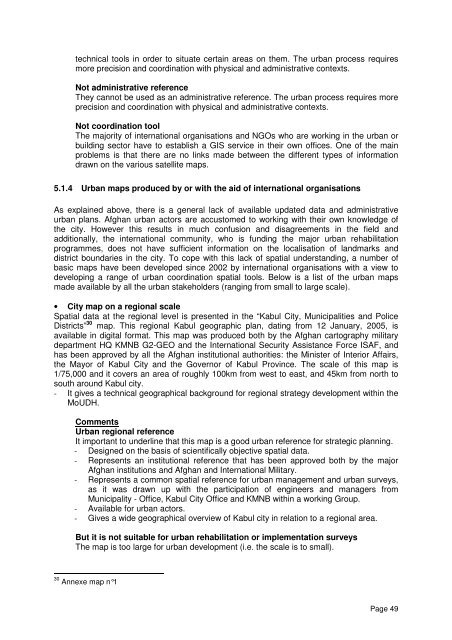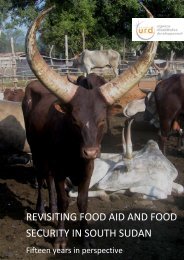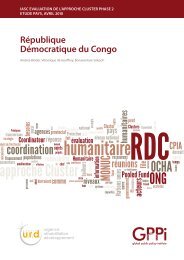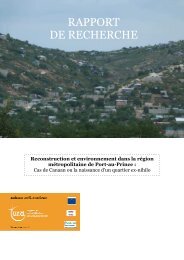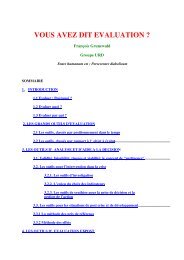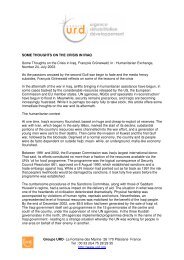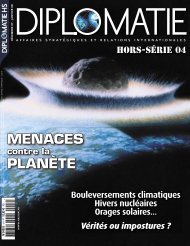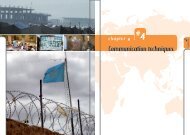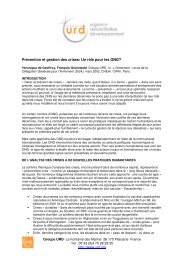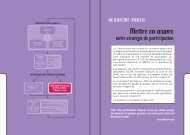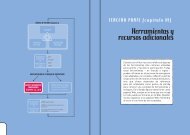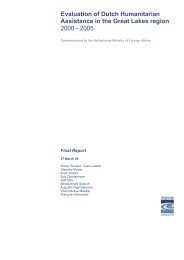Kabul Urban Survey - Groupe URD
Kabul Urban Survey - Groupe URD
Kabul Urban Survey - Groupe URD
Create successful ePaper yourself
Turn your PDF publications into a flip-book with our unique Google optimized e-Paper software.
technical tools in order to situate certain areas on them. The urban process requires<br />
more precision and coordination with physical and administrative contexts.<br />
Not administrative reference<br />
They cannot be used as an administrative reference. The urban process requires more<br />
precision and coordination with physical and administrative contexts.<br />
Not coordination tool<br />
The majority of international organisations and NGOs who are working in the urban or<br />
building sector have to establish a GIS service in their own offices. One of the main<br />
problems is that there are no links made between the different types of information<br />
drawn on the various satellite maps.<br />
5.1.4 <strong>Urban</strong> maps produced by or with the aid of international organisations<br />
As explained above, there is a general lack of available updated data and administrative<br />
urban plans. Afghan urban actors are accustomed to working with their own knowledge of<br />
the city. However this results in much confusion and disagreements in the field and<br />
additionally, the international community, who is funding the major urban rehabilitation<br />
programmes, does not have sufficient information on the localisation of landmarks and<br />
district boundaries in the city. To cope with this lack of spatial understanding, a number of<br />
basic maps have been developed since 2002 by international organisations with a view to<br />
developing a range of urban coordination spatial tools. Below is a list of the urban maps<br />
made available by all the urban stakeholders (ranging from small to large scale).<br />
• City map on a regional scale<br />
Spatial data at the regional level is presented in the “<strong>Kabul</strong> City, Municipalities and Police<br />
Districts” 30 map. This regional <strong>Kabul</strong> geographic plan, dating from 12 January, 2005, is<br />
available in digital format. This map was produced both by the Afghan cartography military<br />
department HQ KMNB G2-GEO and the International Security Assistance Force ISAF, and<br />
has been approved by all the Afghan institutional authorities: the Minister of Interior Affairs,<br />
the Mayor of <strong>Kabul</strong> City and the Governor of <strong>Kabul</strong> Province. The scale of this map is<br />
1/75,000 and it covers an area of roughly 100km from west to east, and 45km from north to<br />
south around <strong>Kabul</strong> city.<br />
- It gives a technical geographical background for regional strategy development within the<br />
MoUDH.<br />
Comments<br />
<strong>Urban</strong> regional reference<br />
It important to underline that this map is a good urban reference for strategic planning.<br />
- Designed on the basis of scientifically objective spatial data.<br />
- Represents an institutional reference that has been approved both by the major<br />
Afghan institutions and Afghan and International Military.<br />
- Represents a common spatial reference for urban management and urban surveys,<br />
as it was drawn up with the participation of engineers and managers from<br />
Municipality - Office, <strong>Kabul</strong> City Office and KMNB within a working Group.<br />
- Available for urban actors.<br />
- Gives a wide geographical overview of <strong>Kabul</strong> city in relation to a regional area.<br />
But it is not suitable for urban rehabilitation or implementation surveys<br />
The map is too large for urban development (i.e. the scale is to small).<br />
30 Annexe map n°1<br />
Page 49


